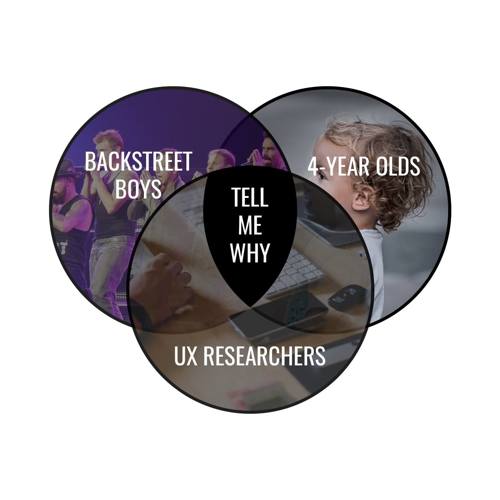
Photo by Nicolas Lysandrou on Unsplash
In part 1 of this blog pairing, we shared what we mean by a research mindset, explored five (of the many!) benefits for businesses and looked at some examples of the research mindset in action.
So hopefully you’re feeling open to thinking like a researcher, but how do you apply that in the reality of competing stakeholder requests, the demand for growth and stacked product backlogs?
Ways that businesses and teams can develop a research mindset
Thinking like a researcher means questioning everything, becoming an annoying 7 year old constantly asking “why?” Question and challenge all aspects, even when it doesn’t feel like ‘your job’:
- What are we trying to achieve?
- Why is this being done (in excruciating detail)?
- What will success look like?
You may have seen this Venn diagram doing the rounds, which captures it brilliantly:

Credit: @OrigamiUx and @DougCollinsUX
Digital products are never ‘done’ but a strong direction and goal will allow you, your team and business to know when you're succeeding in this phase.
A way to make success more likely is to ruthlessly identify assumptions and uncover knowledge gaps along the way. As a fictional (but realistic) example:
This goal starts with a specific solution rather than a problem statement to be interrogated. Rather than asking, how we can start designing and developing this app, instead we would ask:
- How do you know there’s a need for an app?
- What ‘people’ are you referring to?
- Do you know anything about your audience?
- What do you mean by ‘wasting money’?
- What does ‘budget effectively’ mean?
- Are there other solutions (maybe outside of tech) that would help?
There are multiple assumptions inherent in this idea. They often hide in plain sight. Goals don’t need to be lofty and world-changing. The most achievable ones are clear, measurable and realistic.
How you can create a research mindset in your team
While some people will be naturally more curious, there are ways that you can encourage a researcher’s mindset in new and formed teams:
1. Create and ensure psychological safety
This means fostering an environment where everyone feels like they have the opportunity to speak and that their voice will be heard. The groundbreaking work in this area has been led by Amy Edmundson (Novartis Professor of Leadership and Management at the Harvard Business School), explained in her 2014 TedTalk.
Psychological safety aims to remove societal and institutional barriers and it is necessary for innovation and learning. Taking a questioning and challenging approach to make a product or service better is very difficult for team members to do if they feel psychologically unsafe.
2. Align people into collaborative teams
Service and product design involve permanent and temporary teams. Often people from different backgrounds and disciplines are thrown together to try to solve a problem. The added layer of meeting virtually can easily strip away time for chit-chat and getting to know each other. This can feel like a distraction from ‘the work’, but it is crucial for alignment; a better understanding of each other as people is so helpful through challenging phases of a project.
If you find templates and tools useful, this team canvas might be a helpful exercise to go through.
3. Embed research at every stage
We’re aware that every discipline is keen to be involved earlier in the design process. When research is part of a project, it is often factored into the early Discovery phase, which is great. But that is often where it stays - not so great.
In the real-world reality of work with parameters such as finite resources and fixed deadlines, we appreciate that it’s not feasible to have research constantly running in parallel to design and development. In our experience, there are key stages where research can be most insightful:
- Inception: When you’re exploring an idea or to generate new ones
- Discovery: Exploring the problem space, learning about users and the current situation
- Prototype: Does the product/service work? Is there any friction?
- Beta/post-launch: When real users are using it, outside of a research environment
By embedding research at every stage, you will also be encouraging team members to continue to question, listen and learn.
Is a research mindset something you can learn/teach?
In short, yes - absolutely. However, research is a muscle that is stronger when it’s being worked every day. Some research is usually better than no research but it can often be unhelpful if it is rushed, poorly defined or approached with bias. If you’re a manager trying to plan, conduct and analyse research off the side of your desk, it will be a challenge.
Supporting startups to develop a research mindset
In part 1 we shone a spotlight on established organisations such as GDS and LEGO. But what is the benefit of a research mindset for startups?
At Nightingale, we have worked with a number of startups based in a range of industries, from retail analytics, to parking and EV (electric vehicle) charging management. For the most part, these companies were at the very beginning of their journeys, developing completely new products and services.
In startups, the focus is often on developing a MVP (minimum viable product) as quickly as possible and getting it out to market in order to get feedback and iterate the design. The goal is to achieve product-market fit by shaping and iterating the product design to more closely fit the demands and needs of the target market.
The danger of this approach is that, if an MVP (minimum viable product) is created without research, a huge amount of assumptions may be made about what users need - assumptions that may be totally incorrect. These incorrect assumptions may mean that the entire concept of the product is flawed and no amount of iteration will ever make it successful - the outcome being that the product ends up on the huge pile of failed startup ventures.
A startup with a research mindset doesn't run headlong into the market with a potentially flawed product - instead, they step back, gather insight, create and test prototypes and make informed, evidence-based decisions.
We support startups in developing this mindset by working with them to look carefully at their goals, their market, their users and their business model, to think early and in-depth about the future of their product and their company in order to set themselves a clear path to success.
In our experience, startups that cultivate a research mindset from day one reap two major rewards:
- They avoid making obvious, and potentially fatal, mistakes, both in the type of product they create and how they create it.
- Research often uncovers new and groundbreaking areas of opportunity, areas they weren't previously aware of. The key benefit is that it allows the founders to think strategically and holistically about all aspects of their approach, both to product design and to business, to greatly increase their chance of creating a useful, scalable product that their customers love.
If you want to get started right away, our business case template and guidebook will give you a quick and easy way to run through key research questions with your team.
Our webinar for startups will also give you some great tips on how to use research to minimise risk and maximise success.



